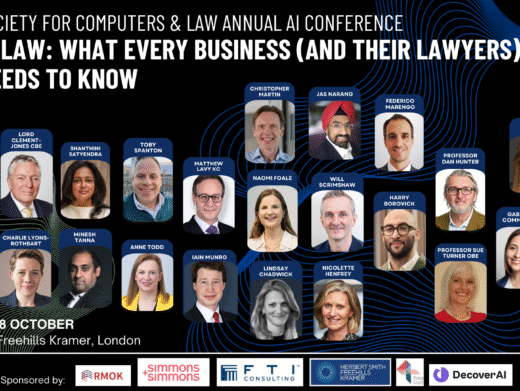Click on the relevant title for Predictions Preview and Predictions 2009: Part 2
From Charles Christian, Editor of Legal Technology Insider
It’s the economy stupid. Any legal tech related predictions for 2009 must be qualified by the big unknown of the state of the economy. If law firms are worried they may not be around this time next year, they are not going to be investing in any new IT systems. Apart from those firms that are having to migrate to new systems because either their legacy systems are on their last legs – or they have lost all faith in their legacy suppliers (and there are plenty of those around at the moment) – just about the only thing anyone is likely to be buying are systems that can demonstrate a rock solid financial return on investment. And that means actual cost savings rather than woolly efficiency benefits.
I think it is also likely that investment in ‘green’ IT initiatives are going to be shelved for the immediate future. In recessionary times, lawyers are going to focus on saving their firms and their jobs, rather than saving the planet.
However one technology we will hear more of in 2009 is cloud computing – it’s the next logical step on from SaaS (software as a service) – particularly with technologies such as RIA (rich internet model) and EC2 (Amazon Elastic Compute Cloud). And, if £sterling keeps on its downward trajectory, IT suppliers may also be having to change all their systems over to euros.
From Chris Dale, the e-Disclosure Information Project: www.chrisdalelawyersupport.co.uk, www.chrisdale.wordpress.com
Digicel Ltd v Cable & Wireless will have an immediate effect on case management of disclosure. No-one – practitioner or judge – can now overlook the Practice Direction to Part 31 CPR after a widely-reported case in which a party was forced to meet with opponents to discuss the extraction of data from backup tapes and to redo part of their disclosure using keywords ordered by the judge. We will see much more co-operation, enforced by the court if necessary. Although Digicel was an application to widen the scope of disclosure, parties and judges will spot its potential for achieving the opposite.
Although the solicitors in Hedrich v Standard Bank beat off a wasted costs application brought against them in respect of disclosure defects, they did so by the skin of their teeth and on grounds extraneous to the defects. Solicitors will keep handy the phone number of someone who can help them with e-disclosure, and services providers can expect calls for pre-emptive advice.
Early Case Assessment will move from being a technical-sounding term to a statement of the bleedin’ obvious. There are new generations of software and services designed to give lawyers and their clients a quick and informed peek into their sources at a reasonable cost, and disclosure will move from being just a formal stage in the litigation process to what it ought to be anyway – an upfront assessment of the evidence early enough to supply both an idea of prospects and an estimate of costs.
This is just as well, because there will be a new focus on the (existing) obligation to discuss sources with opponents and to argue proportionality in front of the judge at the first CMC. That obligation will be buttressed by a new Technology Questionnaire and a Practice Direction dedicated to electronic disclosure.
Generally, the prospect of an increase in work leads to an increase in costs. The reverse will happen as contentious work flows from recession. For the first time in a decade there will be litigation work to compete for, and just at the time (see above) when new early-stage applications become available and when judges are becoming more alert both to the power in the rules and to the power of ECA applications. Which clients are not going to question how the lawyers propose to handle their documents? Answer: those who decide to take much of the work in-house.
From Paul Heritage-Redpath, Product Manager, IRIS Law Business, IRIS Legal Solutions
Computers and law in 2009. Let’s say there are some ‘creative tensions’ between the two given the current climate of recession.
The first is between data security – for client confidentiality – and the trend for mobile working, which will only accelerate as firms seek to shed expensive offices while lawyers look to pare back an increasingly expensive commute.
Specifically, Software as a Service is attractive when looking to cut hardware costs and enable mobile working: attractive apart from the idea of someone else holding your accounts and the data of your clients, that is. There may be a gap in the market for encryption; but quis custodiet ipsos custodes? The reputational loss for a law firm of a government-style ‘Whoops there goes my memory stick’ mishap is horrible to contemplate.
The next tension is between law firm’s clients wanting to pay less, whilst receiving improving and 24/7 service. For how much longer will the profession, Canute-like, be able to hold back the tide of self-service, and the reasonable requirement of clients for online visibility of their documents and billing details? Yet how will this major infrastructure change be funded as fees fall steadily?
Robust and secure high-availability Web applications have proven tough for even the likes of Apple and Microsoft this year with very public failures in MobileMe and Hotmail. Moving from a static brochure site to a secure Web application platform is surely the next challenge for IT directors. Adapting support contracts to cope with liability in a world of inter-operable Web components may be the coming challenge for IT vendors.
Finally, firms will now expect their Practice Management Systems to do exactly that – provide much better visibility of where cash is coming from and where it is going. There is room for improvement across the board in providing business intelligence tools to law firms. That means investment by vendors and clients alike – and the need for innovation comes at a time when there is least cash to pay for it.
Tricky times all round.
From Rosemary Jay, Partner at Pinsent Masons LLP and the Information Law Team there
The next big issue in DP will be accuracy and data quality following the poor quality lending that contributed to the credit crunch and some scandal in which data is found to be grimly poor. The security breaches will also keep on coming probably through internal (ie employee) breaches rather than losses of removable media. Some major law firm will end up in the firing line in 2009, along with a long list of public authorities.
Despite the failure of credit data so far, lenders will put on pressure to get hold of even more personal information to help them lend/repossess safely as fraud continues to increase. Data sharing across the public, banking, insurance and energy sectors to claw back fraud losses will be the top of boardroom agendas and the ICO will clash with the FSA as the latter requires more and more information to be collected about banking customers and shared between newly merged banks – thereby leaving the banks in a tough spot in the middle.
Western credit referencing models will begin to take root in emerging economies, despite their slightly tarnished reputation at home, as CRAs try and seek out new markets. In the UK ‘manage your own credit file’ services will have a good year as people are refused credit and start to take more of an interest in managing their credit file, and question why they are being asked for endless information.
The Government will be forced back on some of its more intrusive proposals following public response but will go ahead with them anyway even if in a slimmed down form The ramifications of Marper (the ECHR judgment that held the UK DNA database should not hold records of those who are not charged or convicted) will start to bite and, against this backdrop, 2009 will see continuing high profile flashpoints in the liberty v security debate, but little will have changed by the year end.
On the growth of regulation, the extension of the Freedom of Information Act to contractors by order will be kicked firmly into the long grass on the basis that ‘its an extra burden on business in hard times’ but FOI requests made to the Government re the banking bailout will clog up the ICO’s inbox. Globally, new privacy laws may well be stalled for the same reason. If we have a general election in the summer and the Conservatives win, we may see a push towards more ‘principles based regulation’ on privacy issues as Cameron looks to cut perceived bureaucracy. Environmental concerns will push the government to again look at legislating on junk mail, despite attempts at DMA self regulation in this area.
Whatever happens we will continue to see a flurry of ‘new initiatives’ many of which are the same old stuff dressed up in new clothes but that finally PIA (privacy impact assessment) technical protection might catch on…
From Iain G. Mitchell QC, Chairman, SSCL
The year will be a year of increased tension between the opening up and the closing down of information.
In one sense information wants to be free, because it is increasingly cheap, easy to replicate and disseminate, and sitting in a cultural context where old paradigms of property are breaking down. This is reinforced by changing cultural aspirations from a generation that is at home with You Tube, Wikipedia and social networking sites, where barriers to the flow of information (and, from time to time, misinformation) are at least permeable if not non-existent.
In another sense, information wants to be corralled, restricted, fenced and meted out sparingly – knowledge and information give power and are of financial value, whilst people rightly expect that their personal information will be kept secure.
These tensions will manifest themselves as follows.
- The impulse of Governments to regulate, control and snoop will increase as rapidly as their ability to succeed in doing so effectively will diminish.
- Well meaning systems of data regulation and control will continue to be frustrated by employees, data handlers and others who, viscerally, fail to take it all seriously – discs, memory sticks and computers will continue to be left on trains, pubs and restaurants, and there will continue to be temptations to share juicy gossip
- More people in the entertainment industry will get to thinking that they need to find new ways to make money which recognise the outmoded nature of the present economic model; those who don’t will notice that the waves which were lapping around their feet are now pretty near their thighs.
- The battle between Open Source and Proprietary models will continue to be fought, but it will still be too early to call.
People who rashly make generalisations will be proven wrong.
From Gregor Pryor, Senior Associate in the Advertising Technology and Media Team at Reed Smith.
My prediction for 2009 is that there will be an ever-increasing amount of emphasis being placed on the way that companies handle and exploit data that is collected from consumer Web sites, both in terms of: (i) the way that they leverage their data to create value for their business by becoming a ‘semantic’ web company; and (ii) whether their use of that data is in line with legal and regulatory requirements. This is very relevant to online media companies; the more effectively they can use the data they collect, the more valuable they become to advertisers and content providers looking to reach an increasingly fragmented audience.
From Pearse Ryan, Partner, Technology & Life Sciences Group of Arthur Cox, Dublin
Writing this from an Irish perspective and looking back at previous predictions, the tone this year will differ considerably. It is difficult to be optimistic when faced with an economic tsunami as I sit here on my private beach populated by my technology practice colleagues and competitors. Putting on a brave face, the following are a smattering of predictions
- Services of all shapes and sizes, but little work on the infrastructure supply side. I doubt whether there will be more than a handful of ERP or similar large scale software projects during the year. What we have been seen for the last few months and will continue to see is mainly service based projects. Generally, these service procurements are on the low to medium end of the evolutionary and financial scales, with quite a lot of IT managed and facilities management type services;
- A continued sparsity of IT or BP outsourcings domestically. With the public sector a non-player (and certainly the closer one gets to central government) the domestic high end outsourcing market is limited. There may be one or two large deals, as is enviable, but that is likely to be the extent, and they will be restricted to the private sector;
- The continued slow take-up of software-as-a-service. The offering seems to work best in conjunction with new ERP and similar software led projects and, as above, such projects are likely to be few and far between. It would help the customers if the larger suppliers demonstrated a modicum of flexibility in commercial and legal negotiation;
- Steady development of IT dispute work. During the good times this was a rare work species, but the economic climate gives customers with problem child projects less ability to indulge wayward suppliers. Also, a growth in customer disputes with database and application software suppliers looking for increased payments based on audit, tip-off or sheer opportunism. Sooner or later, we may actually achieve an Irish IT/outsourcing litigation which proceeds before the Commercial Court all the way to judgement;
- A tightening up of contractual requirements by the public sector, possibly originating with the Chief State Solicitor’s Office, representing primarily central government. This would be of assistance to lawyers acting for the broader public sector, who frequently find themselves out on a limb in negotiating with the large IT suppliers. While the positions adopted may have merit, they lack official sanction;
- On the data protection side, we expect continued growth in what has been a busy area for quite some time now. Also, we can fairly confidently predict further and greater high-profile data outages. Draft legislation has been prepared to require the mandatory reporting of data security breaches in the financial services sector and we would expect a fairly broad political consensus on the matter; and
- On the private sector side, continued good deals concluded by private equity. Those with the capital are the rich kids in the sweetshop at present, a trend which one can only see continuing.
All in all, 2009 looks set to be a tough year. However, depending on one’s firm and practice area, the grey cloud may have a silver lining. The mooted consolidation in the financial services sector should give rise to some large scale M&A activity, which could have some considerable issues in IT and service consolidation. Data protection will continue to grow. Also, we see a likely increase in cost-cutting based service procurements. After that, we must wait and see.
From Linda Webster, Head of IT, Wedlake Bell: www.wedlakebell.com
Lawyers now accept that IT is a business critical tool and no longer consider technology a ‘necessary evil’. This change in attitude is crucial in allowing businesses to embrace new technology and explore ideas about how systems can assist in working more smartly. The shift is partly driven because law firms now see themselves as a business, and partly by the fact that computers are accepted as a component of our daily lives. Firms are looking closely at every area of the business from how clients are attracted and retained to the methods in which work is produced. This gives those working in IT an opportunity to use systems in an imaginative way.
I think that the following will become increasingly significant in law firms next year:
- Software as a Service. Historical reluctance to allow information to reside on servers which are not under the control of the firm is diminishing. Many firms use on-line backup and external email scanning and storage solutions, so taking the next step has become easier to contemplate. Cost implications will be the driving factor in the uptake of this model.
- Web 2.0. Firms will utilise social networking tools in order to maximise relationships and collaboration within and across teams as well as with clients. Different ways of working and of delivering applications and information will continue to be explored.
- Profits and IT. Firms will look towards IT in order to maximise profits, implementing systems which will save time in getting work done. Systems should be implemented with a view to ease of use and the minimum of training required.
- Unified messaging. Adoption of this will increase. The ability to consolidate telephone systems with the computer desktop is compelling.




